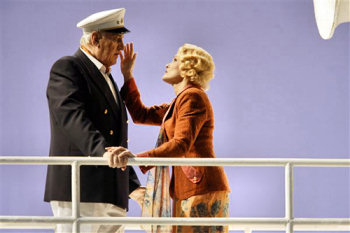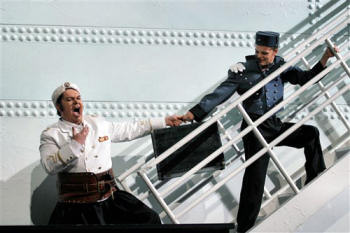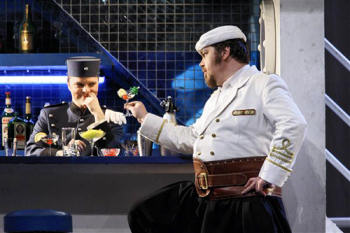Mozart, Die Entführung
aus dem Serail at the Finnish National
Opera, Helsinki, 21.4.2006 (GF)
Conductor: Ralf Weikert
Director: Dieter Kaegi
Set and costume designer: William Orlandi
Lighting designer: Roberto Venturi
Cast:
Konstanze: Anna-Kristiina Kaappola (soprano)
Belmonte : Juan José Lopera (tenor)
Blonde: Dilbèr (soprano)
Pedrillo: Dan Karlström (tenor)
Osmin :Jyrki Korhonen (bass)
Selim : Pekka Salomaa (speaking part)
Finnish National Opera Chorus and Orchestra

This Entführung aus dem Serail was premiered
in February 2003 and now returns for another round
as part of the Mozart celebrations with the same conductor
and most of the soloists brought over from the original
cast. The only new names are Juan José Lopera
as Belmonte (replacing Topi Lehtipuu) and Pekka Salomaa
as Selim (Tom Krause, no less, took this speaking
part in 2003).
As is so often the case nowadays the story has been
transferred, from the castle of Selim Pasha in the
16th century to the 1920s and is set on board a cruise
ship captained by Selim. The idea is original and
funny and it works surprisingly well, at least if
one knows the original story – then this becomes
a surprising and entertaining excursion from the mainstream.
Probably it works similarly well with newcomers to
the work, who are informed in the programme book about
the changes. It also has its drawbacks, which I will
try to sort out in due time.

The sets are the side of the ship, which can be raised
and lowered and also moved sideways to provide a variety
of different milieus. During the overture the
passengers enter the ship, where Osmin checks passports
and tickets and two members of the crew are busy replacing
the old name of the ship with letters constituting
the name KONSTANZE. There is a lot of business going
on during this embarkation, so much so that they sometimes
threaten to drown the softer parts of the overture.
Generally there are a lot of gags all through the
performance, much of it witty and stylish, some of
it too much of the slapstick kind. Since this is a
cruise ship both the chorus, who have little to sing
in this opera, and a large number of extras are employed
in a variety of roles: partying, sunbathing, playing
and just mingling in the background, and of course
when the action is set in modern times there are people
taking photos (but why equipped with mini-cameras
and electronic flashlights? OK, Leica mini-cams were
introduced in 1925 but the flashlights?) The captain,
Selim, is greeted by an ad hoc choir, sheet music
in hand; Konstanze sings her Martern aller Arten
against a dark background with an enormous ship propeller
looming threatening above her – what kind of
torture does this allude to? The scene where Pedrillo
makes Osmin drunk takes place in the bar of the ship
and poor Osmin, after saying a prayer that Allah won’t
see him, gets stoned after one Dry Martini. The attempted
escape is carried through using a lifeboat and here
logic falters, since when reconciliation is reached
and Belmonte and his friends are free to leave Selim’s
castle (in the original version) they do so here too,
in spite of being in the middle of the ocean. Logic
of course isn’t always opera’s strongest
suit and this production provides 2½ hours
of excellent entertainment.

Musically it is also well up to the requirements.
Conductor Ralf Weikert has an impressive list of merits,
not least in the Mozart field: he received the Mozart
Prize in 1966, the Karl Böhm Prize in 1975, in
1981 he was appointed chief conductor of the Mozarteum
orchestra in Salzburg and he has conducted in most
of the great opera houses. He knows his Mozart and
has a firm grip of the proceedings with sensible tempos
and good precision, a minor slip in one of Osmin’s
arias apart, caused by an early entry from the singer.
In the rousing overture he at once set his mark on
the performance and the comic elements were well taken
care of through the opera. But of course Die Entführung
is not only comedy, far from it; Konstanze is constantly
depressed up to the final ensemble and her three arias
were given fine lyric-tragic readings.
The three-act opera is performed with only one interval
and the break comes after Konstanze’s Martern
aller Arten. Instead of beginning the second part
with Blonde’s and Pedrillo’s spoken dialogue,
some orchestral music is inserted, accompanying the
passengers in sundry sports activities. The dialogue
is generally well executed, but since Konstanze is
so depressed and Selim’s part is performed in
a low-key manner, there is some loss of momentum in
their scenes. Selim is a notoriously difficult part
to put life into and the only wholly successful assumption
of it I can remember is Oliver Tobias’ in Solti’s
Covent Garden production from 1988. He is young and
frightening and the production is on DVD.
I suspect that the dramatic Tom Krause in the original
cast might have been able to inject more life in the
part.
The singing is first-class, with Anna-Kristiina Kaappola
executing her difficult arias with aplomb, missing
only the last ounce of warmth. It is a tough part
to sing with two long arias one after the other separated
only by some spoken dialogue. As Blonde, Dilbér
is in her element. She keeps her vibrato, which sometimes
during later years has tended to widen, well in check
and she rips off a couple of brilliant top notes.
Besides that she is a wonderful actor, something that
also goes for Dan Karlström and his somewhat
piercing voice is used to good effect, but he can
also deliver a lyrical serenade, Im Mohrenland
gefangen war.
Some hardness is also detectable in Juan José
Lopera’s voice when under pressure but in general
he is a near perfect Belmonte. He is no newcomer to
the National Opera – almost a year and a half
ago he was an excellent Ramiro in Rossini’s
La Cenerentola, a performance Bill Kenny also
saw and reviewed enthusiastically on this site (see
review). He negotiates the runs and leaps of Ich
baue ganz with ease – a real challenge to
any lyric tenor.
From earlier acquaintances with Jyrki Korhonen I expected
him to be an ideal Osmin. His is a captivating stage
presence and he has one of the finest bass voices
now before the public. His basically warm and round
tone reminds a great deal of Kurt Moll’s. Few
bass roles are so grateful for a bass with acting
abilities but surprisingly enough his lowest notes
seemed to lack the last degree of power, but otherwise
it was a formidable performance.
In spite of some objections – or call it carping
– this production of Die Entführung
aus dem Serail is well worth a trip to Helsinki
to see. It will run until May 9th and Mozart lovers
willing to stay a couple of days will be able to see
both Die Zauberflöte and Le nozze di
Figaro.
Göran Forsling
Photographs © Finnish National Opera/Finnish
National Ballet, photographers Heikki Tuuli and Sakari
Viika.

